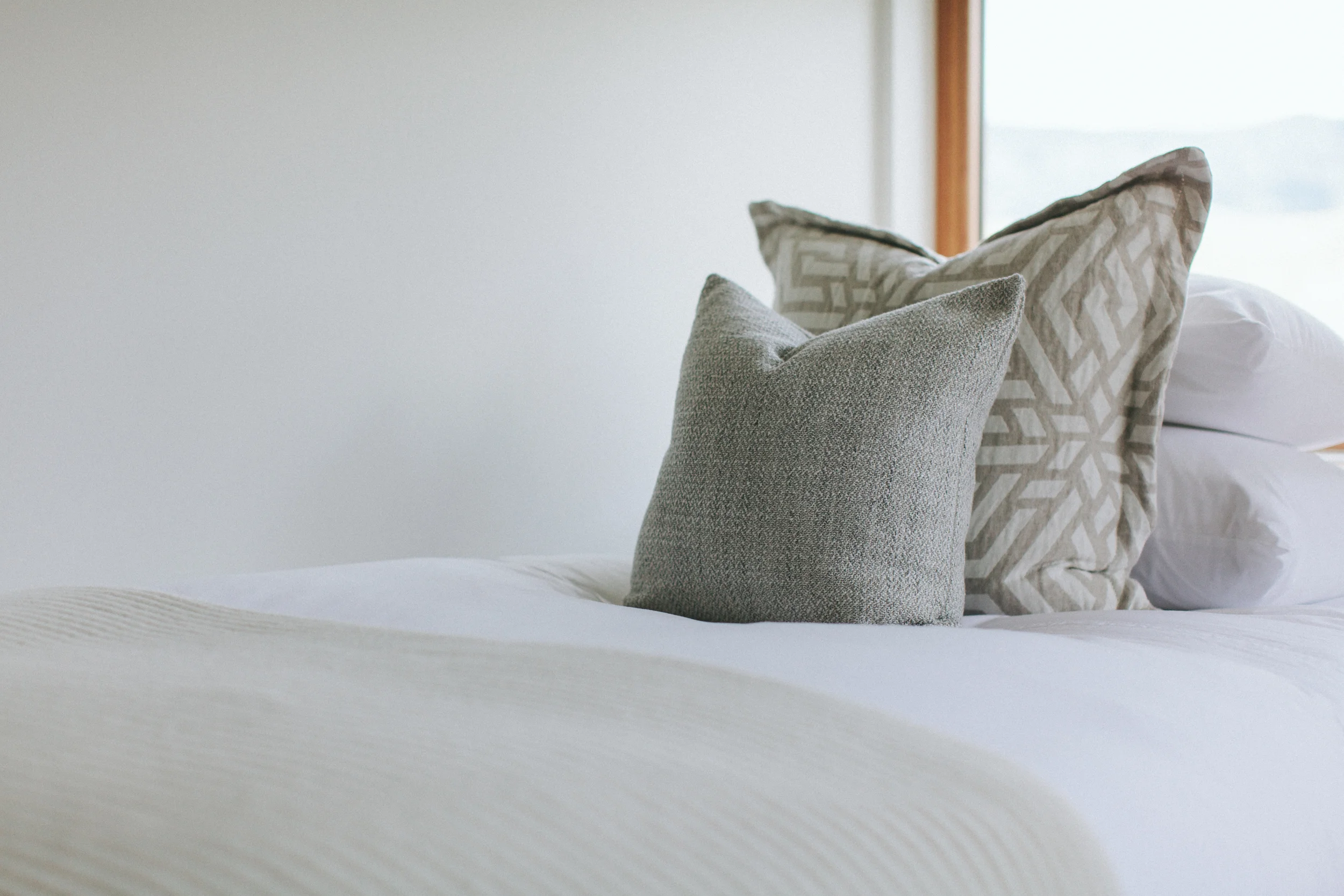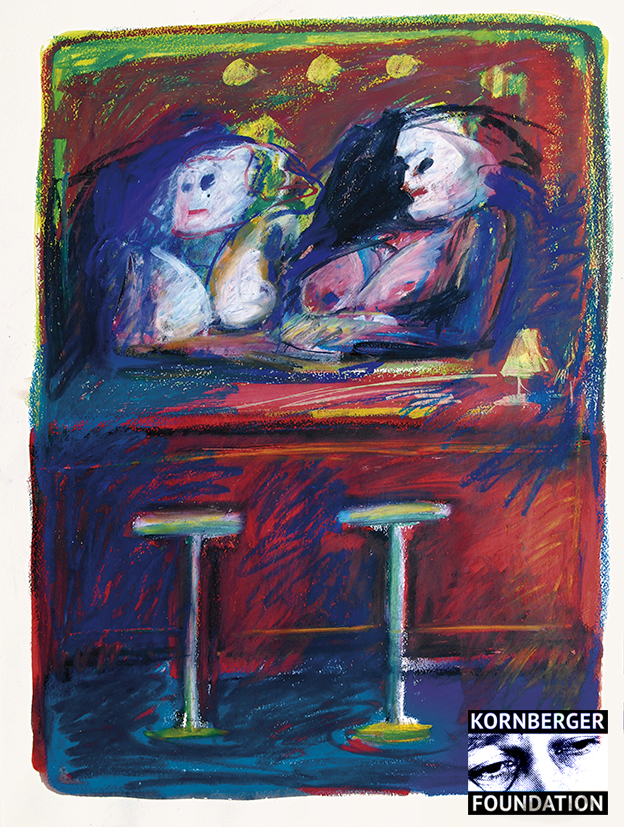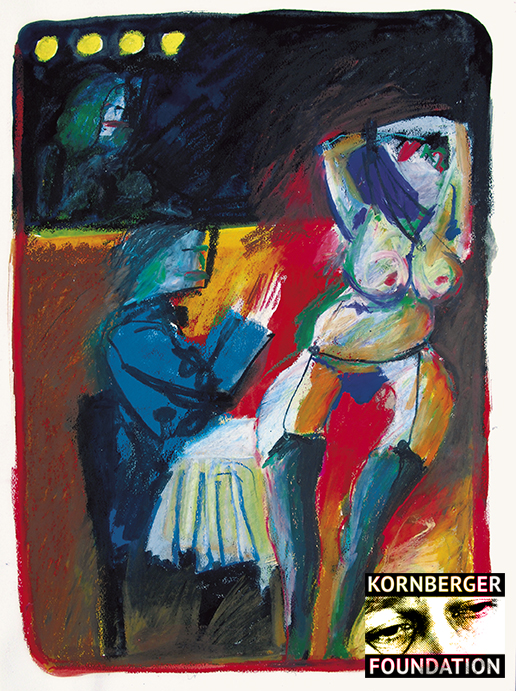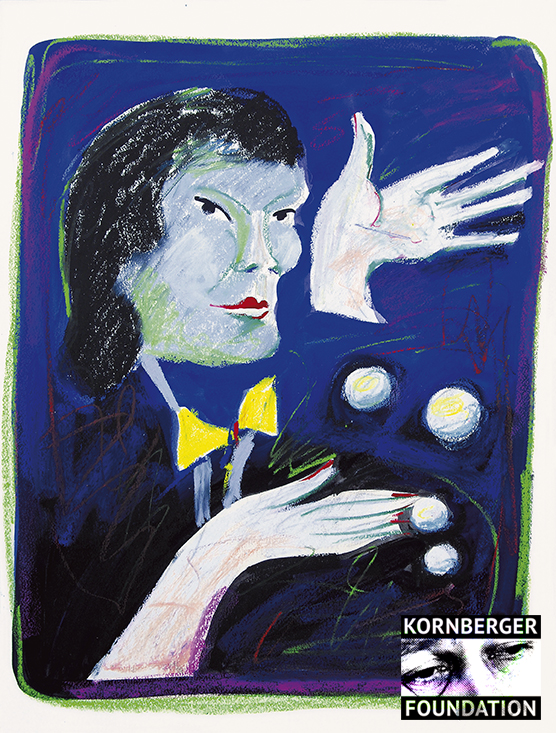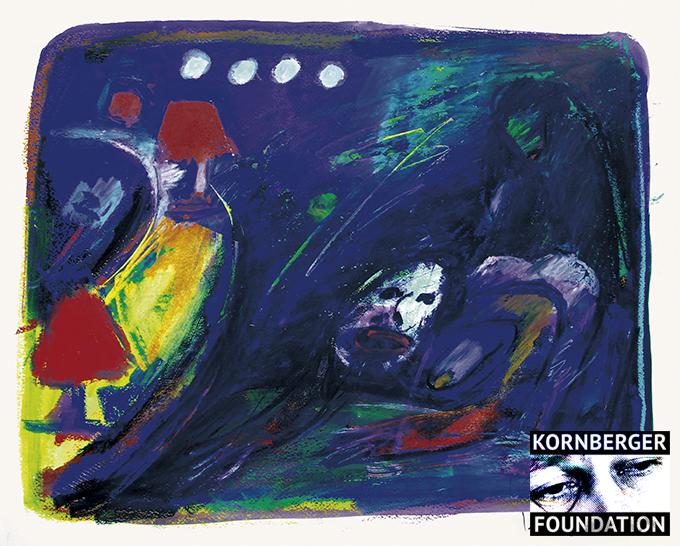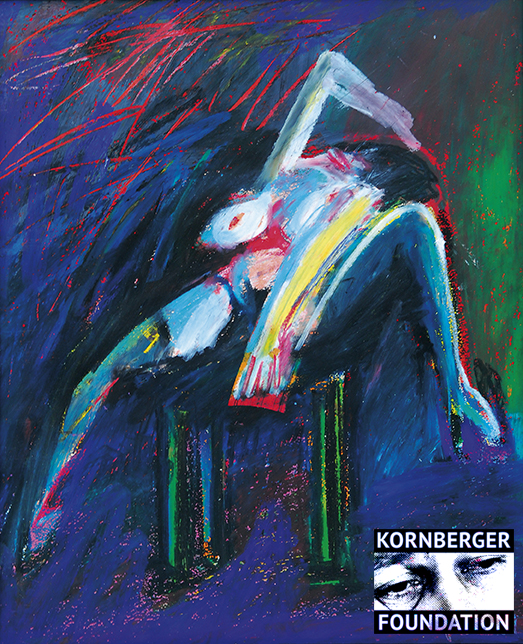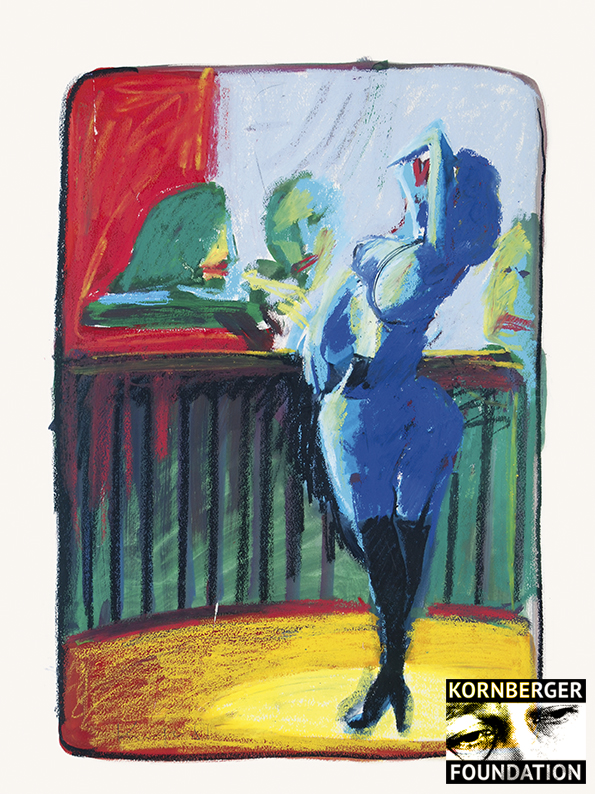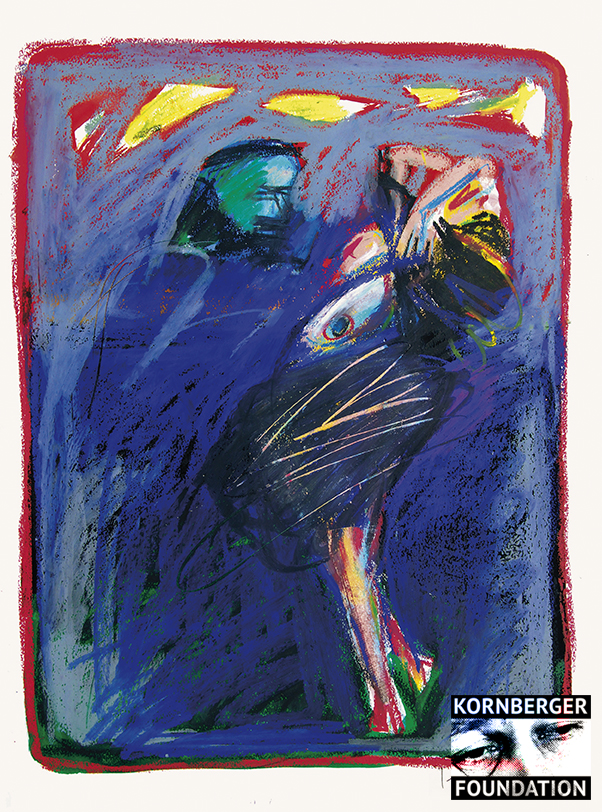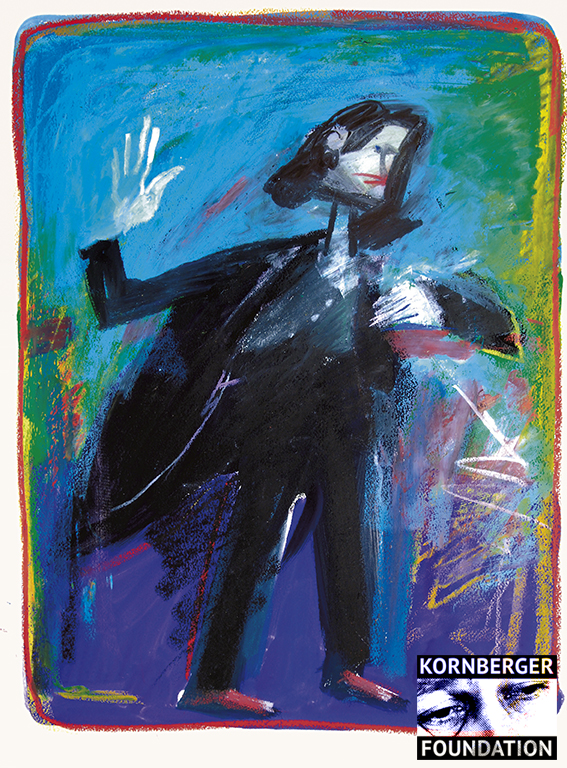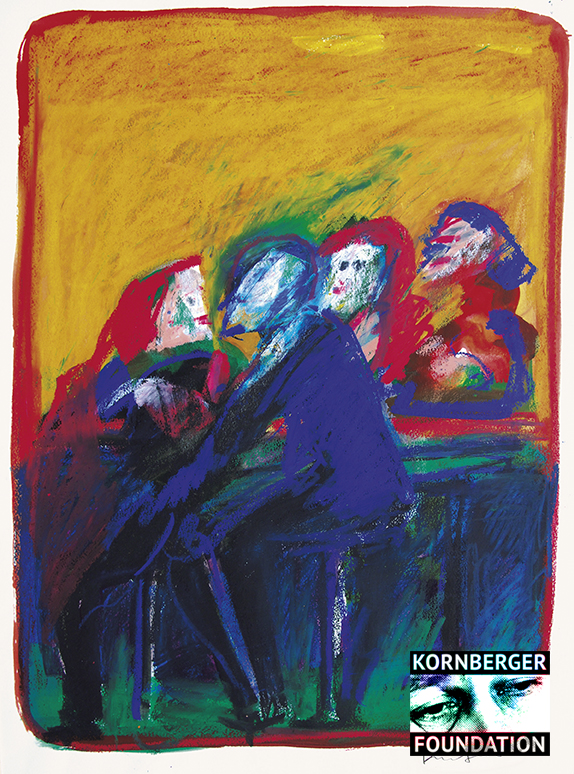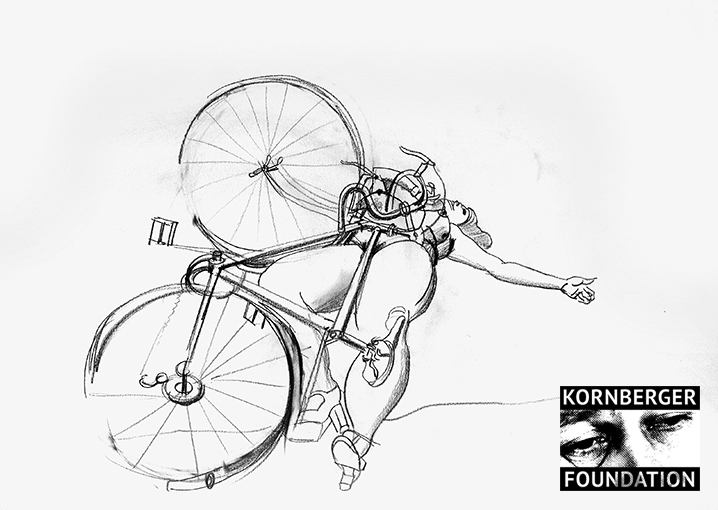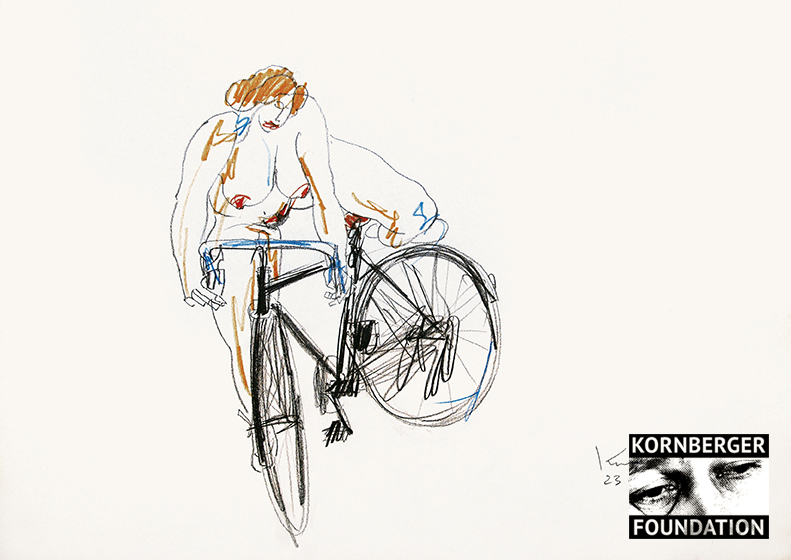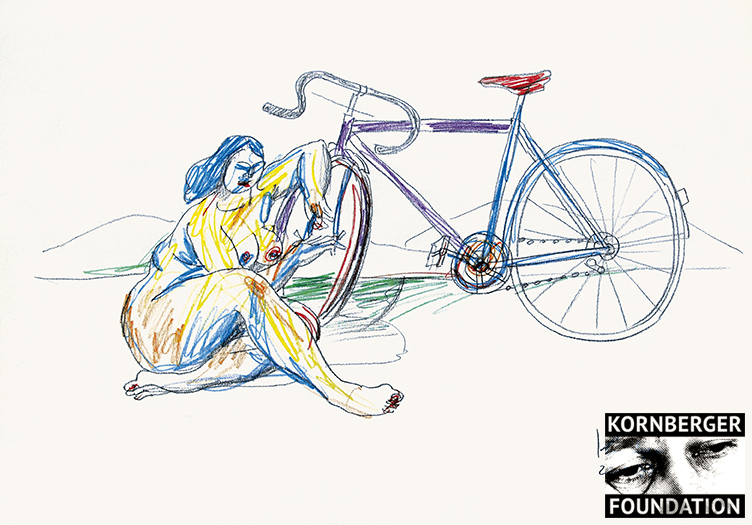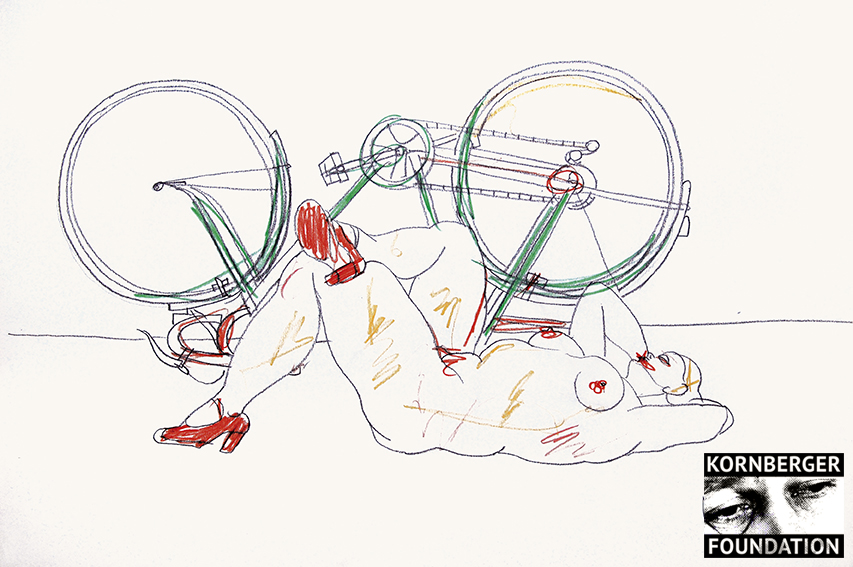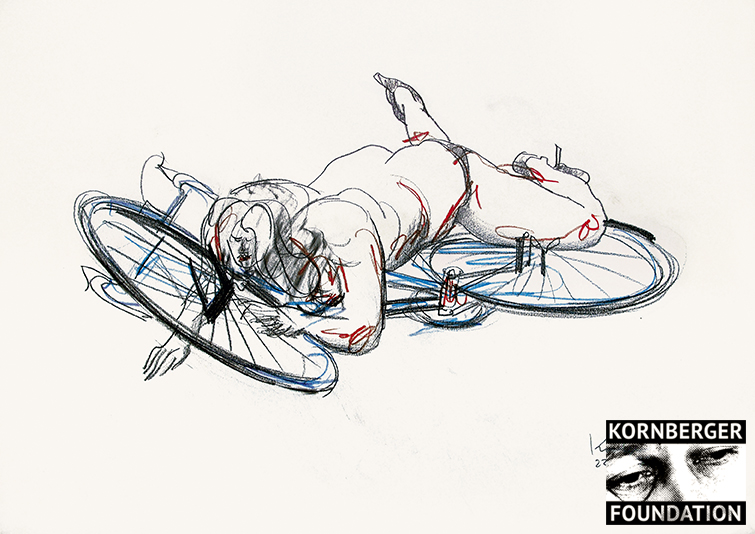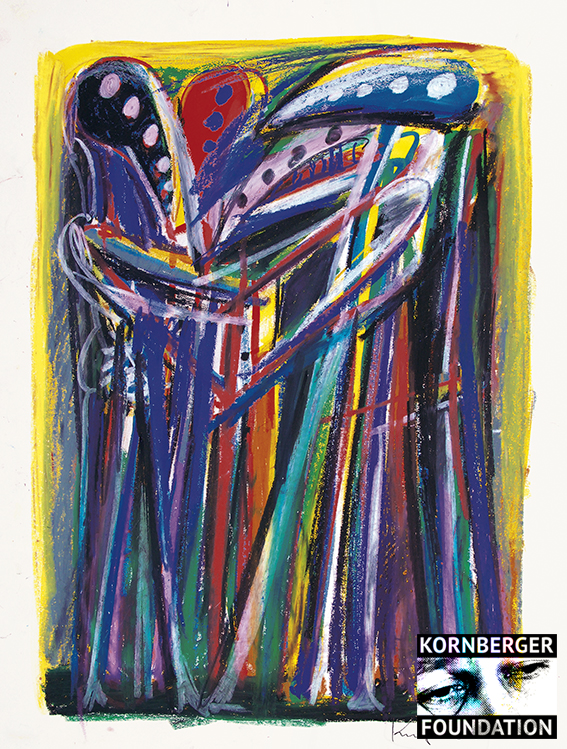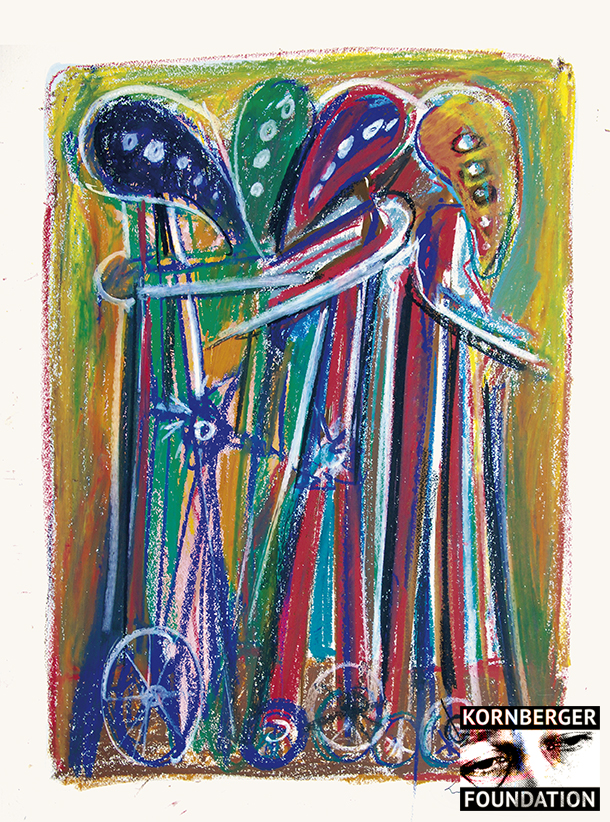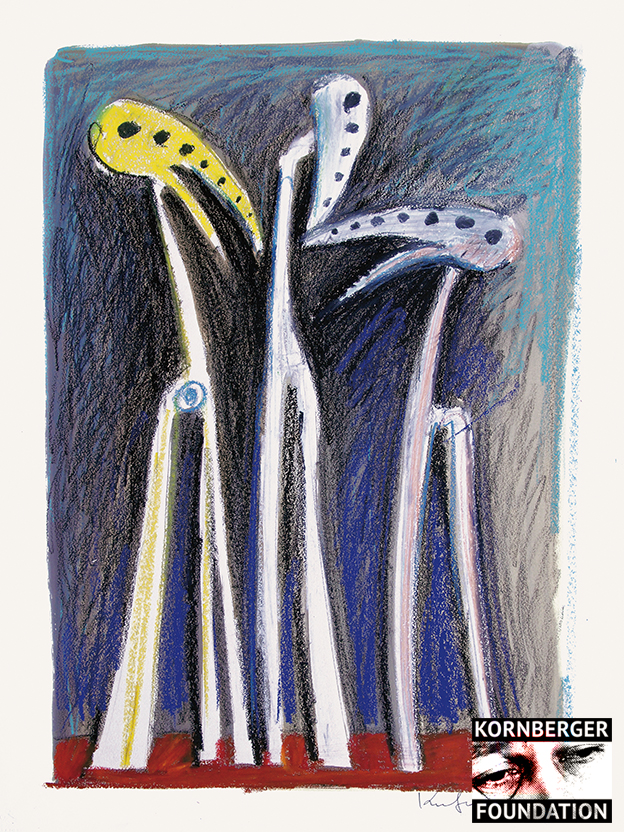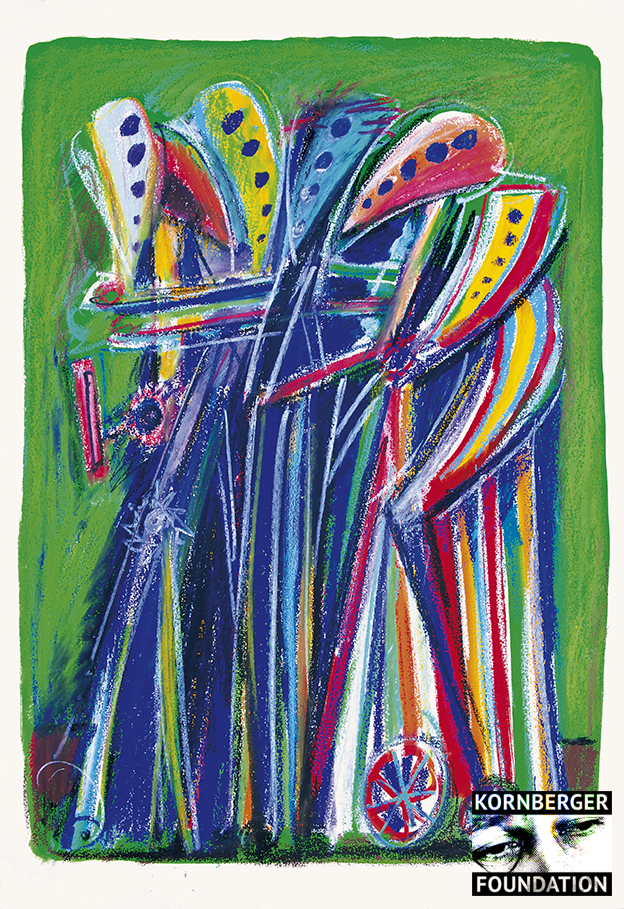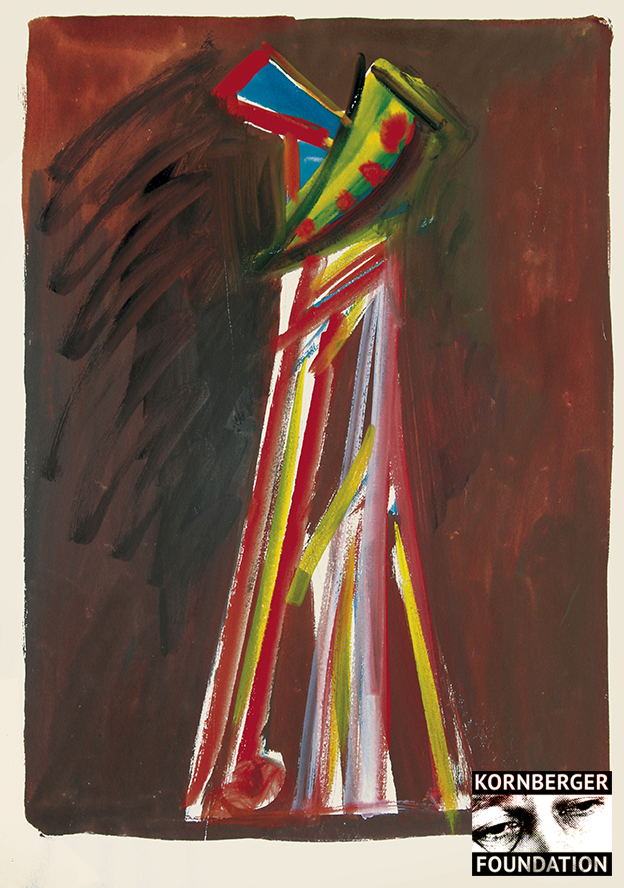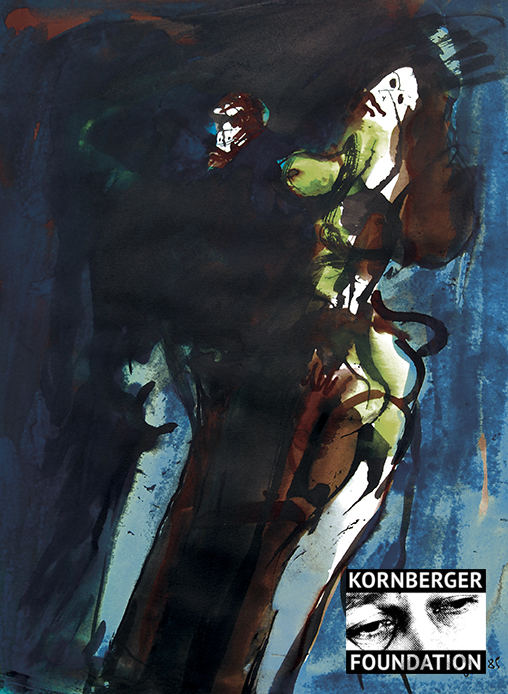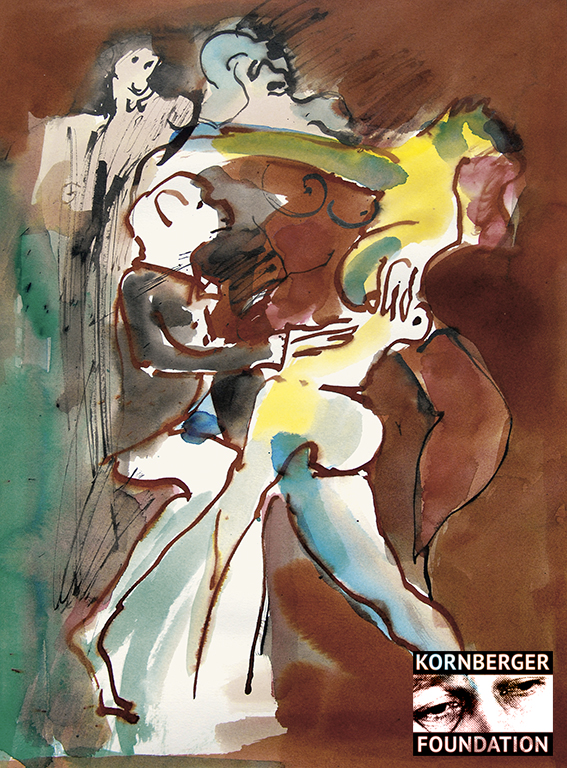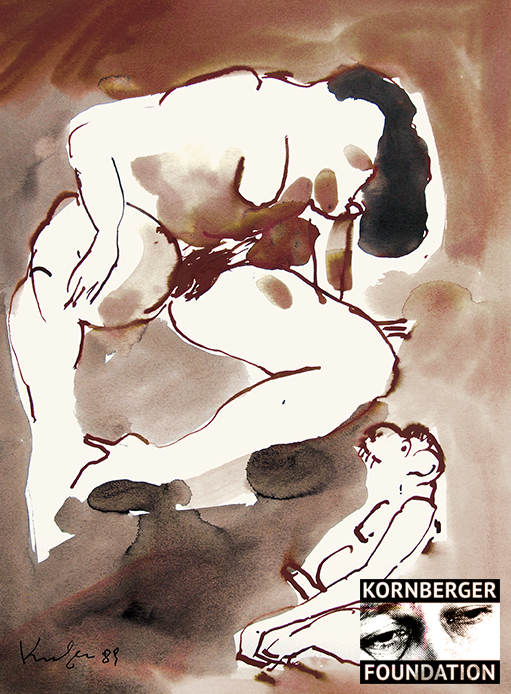Alfred Kornberger FROM THE VIEWPOINT OF curators, collectors and gallery owners
Women, Bicycles, Zeus, Apes and Other Things.
Notes on the paintings of Alfred Kornberger
Painting in our age ist colourful. Colourful in a varied and pluralisticsense. Many options are open simultaneously: the abstract, figurative, expressive, constructive, conceptional or political. The Avant-Garde come and go and fight with each other. Traditions are upheld. New styles are promulgated. And many things, while seeming to contradict each other, mean the same.
The work of Alfred Kornberger falls into the category of conservative and extremely picturesque. „The Fellow with the Painting Claw“ was the titel of a contribution which I once wrote about the artist in the magazine „Visa“ (May 1985). I saw him then and still see him today as a genuine, good painter in the traditional sense. He is a real painter, a deft painter – truly, one with „a painters claw“.
He is something – and this fits in with his „painters claw“ – of a bon vivant. And all of this flows into his pictures, into sensuality, vitaly, joy of living and enjoyment, into optimism. Although, recently (End of 1980s), a few traces of scepticism and a hint of pessism have crept in. All of this Kornberger turns into works of art, into brush strokes, into colour, into composition. Readily and very skilfully he also cultivates the seemingly obscene, as in his pictures with the strip-tease dancers.
He has dedicated many of his works to the subject of dancers at Vienna’s Moulin Rouge. Dominant her are the „artists“, often exaggeratedly exotic or even Valkyrie-Erotic, women like those in Fellini-Films, housemaids or masks of men. The female-male relationship in the painted world of Alfred Kornberger, is changeable – full of victories and triumphs, but also full of defeats.
The good painter and the excellent drawer
„Zeus importunes a Woman“ is the characteristic title of an oil painting of Alfred Kornberger. There are approximately 100 works by the artist on the theme of Zeus: oil paintings, gouaches, pastels, coloured pancel und pancel drawings. Sometimes Zeus loves, sometimes he admires, sometimes he importunes, sometimes he transforms himself into fog. Why? Before or after?
The artist tactfully remains silent on that subject. His business is painting, not gossip. Although he uses strong symbolism in his Zeus paintings and drawings, he never becomes primarily symbolic or literary. It should be emphasized that he has, above all, converted the sensuality and voluptous paintings. This is brought out by the clours, the way he applies them, the style of painting and the composition.
As an artist, Kornberger is not an avant-gardist. He could be described rather as contemplative and somehow – despite his inclination for good-living – bound to tradition in his bastic attitudes. But he is always a good painter and an excellent draughtsman and graphic artist as well. This is demonstrated, for example, by his Zeus drawings and the portfolio of coloured nude lithographs.
Alfred Kornberger embarked on the Zeus theme in 1977. At that time he made drawings of a model with a bicycle and called this series „Zeus“: the foremost of the gods, with his tendency to get involved in amorous escapades, assumes the masculine form of a bicycle, an increasingly abstract structure made of rods – a machine. Zeus the Masculine, the Transformer,, and, at the same time, the Constructor and the object constructed.
In the works of the artist, too, Zeus transforms himself: the form of the bicycle sometimes recedes and the loving couple comes more and more to the fore, symbolised by a strange saddle/skull shape. In some of the oil paintings dating from 1983 and 1984, the figure of rods predominates once again. It is often painted in a very free and impulsive style, in duplicate or in triplicate, and sometimes it stands out in interesting contrast to the female figures.
Discipline at painting
Just as women, his models, are an intrinsic part of Alfred Kornberger’s art, his studio, too, is an important factor of his artistic creativity; it is the place where he works, the place where he teaches, the place where he holds studio parties, and it is also the subject of several skilfully executed interiors. Here, Kornberge’s artistic discipline is unmistakable. The still-lifes of the 1980s are further evidence of his discipline, and their artistic quality lies again in their restraint. They are skilful paintings on everday themes. In the variety of his subjects, too – ranging from full nudes and masterly portraits to abstract stilllifes – Kornberger demonstrates both, his artistic and his intellectual versatility, in oil paintings as well as in gouaches and drawings.
Excellent examples of his versatility are his critically committed serie „Thoughts against Power“ (which includes a „General“, a comic-ironic portrait in wax-crayons on paper) and his more recent apocalyptic series „Envy and Hatred“. Once again, the vivid style of his painting reflects a doomsday atmosphere, particulary „The Locusts“ (End of 1980s), which shows a very different Kornberger from the one who painted the pictures of women. Here, despite his reflective mood, he expresses himself in concrete terms in colours and outlines which lend mobility – the distinctive quality of any good painting – to his compositions.
Recent evidence of Alfred Kornberger’s graphic skill – and he makes preliminary drawings for many of his large paintings – was furnished by his „Ape and Woman“ series (1989). With just a few ink strokes, or sometimes with an ink wash and, at a later stage, added with water colours (personally, I prefer the precision of the black and white drawings), he outlines the occasionally tragic-comic play between the sexes: getting to know each other; dancing; seduction and rejection; masturbation; and – often – taming.
Quality intensifies impressively
This „Ape and Woman“ series could be regarded as the antithesis of the „Zeus“ series of the late 1970s. This is what the artist has to say about his latest series: „ Here the women are training the little monkey – the man. This is just the reverse of Zeus! There the male was the aggressor.“ And now there is a hint of scepticism here. More than twelve years have now gone by since the „Zeus“ series was completed. However, the high quality of the drawing remains unimpaired, and, in most of his works, it is even more striking than before.
Looking back on Alfred Kornberger’s paintings and drawings over almost twenty years (1970 till 1990), I arrive at the following conclusion: if, in our present age (1990) of many different trends and fashions, there is ever any need for an advocate of artistic painting in a style which is traditionalistic and which has the characteristics of expressionism and, above all, of French Fauvism, a suitable candidate for this position could, undoubtedly, be found in Alfred Kornberger and his works.
Dieter Schrage (Artcurator;, out of the first monografie „Alfred Kornberger – Pictures and Graphics – 1954 till 1990“; Edition Alfred Kornberger, Vienna 1990).
----------------------------------------------------
"The nude as innovation"
Austrian art of 20th century knows a number of prominent artists who harbored a particular fondness for the female nude model. Here Gustav Klimt especially stands out, who worshiped a female aesthetic which crucially shaped the female type of the fin de siècle. With rapid pencil outlines Klimt had captured his nude models on thousands of sheets. Like Kornberger, Klimt often created in rapid succession many versions of the same model from different angles. Klimt always sticks to the aesthetics of the female beauty, his eyes barely penetrates the psychological levels of its models.
In contrast however the young Egon Schiele valued the work with models. Not infrequently, individual features of his models were used as an opportunity to exaggerate facial expressions and gestures in an expressive form. The formal traits of Schiele's nudes in pencil, gouache or watercolor go far beyond that of Klimt. He makes an essential statement on the mental state of the represented persons by the manner he uses nude models in the paintings, with the way he defines their relationship with the empty space and at times cuts-up and fragments. Expressive gestures and idiosyncratic body contortions contribute further to making the viewer respond often with surprise and puzzlement in the face of such an idiosyncratic view of the artist. Even Alfred Kornberger always surprises the viewer with the most unusual focusing on certain body parts or expressive potential of his models.
Both in the case of Klimt and Schiele, one can speak of an obsession of the artist with the female nude. Austrian art is also familiar with the case of an artist with obsession for the male nude. There are known three thousand drawings by Anton Kolig, one of Schiele's contemporaries, which he has devoted to the male nude. Characteristic for Kolig is the decades' long constant remaining motif choice. Kolig always shows young attractive men, who lie calmly in a passive position on a bed or sofa and are engaged in absolutely no activities. Compared with the nudes of Klimt, Schiele and also Kornberger, Kolig surprises with the precision of his drawing. Thus we find in his sheets no sensual aesthetic or expressive exaggeration, but a strict naturalism, which holds the male body in a controlled, almost sterile linearity.
Nude representations belong to the fixed repertoire of many artists of the early modernism in Austria. So that Herbert Boeckl devoted the main part of his painting and drawing works also to the female nude. Boeckl's work, which extends from the inter-war period until the early 1960s, shows the nude in a wide stylistic range, which is initially located in a gestural and expressive, much later, in a figurative painting removed from any academic aesthetics. Other painters in turn stress, even in the sophisticated century, the ideal of feminine beauty taught by the academics, such as the Upper Austrian painter Anton Lutz, who still pays homage to a great extent by age in the 1980s to the nude in an impressionistic naturalism.
Kornberger's contribution to the Austrian painting of the twentieth century lies partly in the exclusivity which he grants the female nude subject in his oeuvre.
There is hardly a comparable case, where an artist withdrew to such an extent into his studio, barely traveled, paid little attention to the galleries and exhibitions, the only spend as much of his free time as possible working with nude models. Kornberger preferred to fulfill his desire for companionship by inviting as many nude models to his studio as possible. Kornberger worshiped in his work a feminine ideal that was not satisfied by the trivial aesthetic of a superficial eroticism. His pictures provide a rich material for a variety of discourse between stylistic variation and pure painting.
On the other hand, Kornberger's works reflect the stylistic developments of almost five decades from 1956 to 1996 in rapid succession. The stylistic keyboard on which Kornberger plays masterfully, spans from the reception of Picasso to the smooth aesthetics of Pop Art, and up to the gestural, the colorfully intensive Neo-figurativism of 1980s. In addition, Alfred Kornberger is one of the greatest colorists in the painting of the late twentieth century. Even before the form the most important factor for Kornberger's expression in his paintings is color. In a stunning pictorial drive and gesture Alfred Kornberger creates in each image anew the unity of formal penetration and color design. Rarely has an artist worshipped pure painting so radically and exclusively as Alfred Kornberger.
Franz Smola (Artcurator; out of the monografie and directory of the oilpaintings „The Nude as Innovation“, Brandstätter Publishing, Vienna 2007).
----------------------------------------------------
Alfred Kornberger...
... and his first pictures we saw in 2007 at an art-fair. The work "The Scream" impressed us so much that we bought the picture immediately. We did not know the artist - but from that moment on, he should not leave us.
Alfred Kornbergers images are vivid, suspenseful, often mysterious works. They live, in the true sense of the word, of a color-intensive, dynamic and expressive gestures. That belongs to his nude motifs, to his figurative work and especially to his gestural figures. Almost every work includes a dramatic concept, a composition. Like no other painter, Kornberger knows to use the unpainted white canvas or the overpainted dark areas to produce an often unpleasant tension – or to create and demande open spaces for own interpretation.
Alfred Kornberger was a genius manic painter in a positive sense. A constantly seeking, finding and converting artists. One, who had to reach his own highest standards. A tireless, industrious worker (with a working volume of approximately 4.000 oil- and paper works). A difficult, more versatile and multi-faced character. A man who loved and admired women and a man who women loved and adored too. One, who is acting against all conventions oft the artmarket and went his way unwaveringly.
In our 30 years of involvement with the visual arts, we have discovered only a few comparable painter. Alfred Kornberger had or has enough quality and diversity for an international career. We share the comparisons of art historians and museum curators with Egon Schiele. In our view this is true, but "only" for the female nude, the supreme discipline in painting. There are only a few artists after Egon Schiele, who have dealt with similar intensity and skillfully with the female nude like Alfred Kornberger.
But Kornberger also has taken up other issues which are completely exceptional, not only for his work but also in the art of his time. This applies in particular for his figurative works and for his gestural motifs with the numerous portraits, figures and scenes which he creats in his inimitable intensive dynamics. In this way he has also created an own and new artistic language. Pure avantgarde combined with perfect handwork.
Kornbergers Images include always new discoveries, even a long time later. This belongs to the resolution of certain figure arrangements, for the appearance of an over-painted person (which suddenly becomes the main focus) or for hidden representations by himself. Like Alfred Hitchcock in his movies, he is also hidden in many of his paintings or consciously involved, you have just to discover it, but never forget about his desire for abstraction. His images become never boringly, his works require an intensive examination, his pictures speak. All like movies and also on canvas - captured for eternity.
Michaela and Christian Czaak (as collectors & gallerists; from the catalog „The Spectrum of the Universum“; Artisthouse Vienna, Vienna 2013).
----------------------------------------------------
Alfred Kornberger, a Bonvivant with a painter’s claw at the Vienna Artisthouse
One with a „Malerpratzen“ (that means “the lad with the painter’s claw”) and a Bonvivant called him Dieter Schrage, the most important curatorial companion Alfred Kornberger. There are only a few of that kind and if such an artist is exhibited in the Artists' House this must be duly acknowledged.
During his lifetime, he has exhibited himself at the Artists' House, which he joined in 1979 and which distinguished him in 1990. That was in 1989, I worked in the Lower Austrian Provincial Museum and at the exhibition i had my first encounter with the distinctive artistic personality Alfred Kornberger. The encounter led to further acquisitions by the State of Lower Austria, which studio visits preceded, visits which are remained permanently in memory. There has been no exhibition, he was stil living and there was so much other work up to time with much older and some already deceased artists which had remained more or less invisible or threatened to become forgotten.
The more I enjoyed than 2007, five years after the untimely death of Alfred Kornberger the great, the "Act as an Innovation" dedicated work of Franz Smola appeared and now the collector and gallery owner Christian Czaak approached me with the idea of retrospective to Alfred Kornberger at the Künstlerhaus. To him and the family of the artist together with the art historian and curator Gabriela Elias Koschtzky it is owing, that in the year in which Alfred Kornberger had celebrated his 80th birthday, nearly a quarter-century after the first exhibition, a second large Kornberger-Exhibition at the Artists' House of Vienna becomes real.
At a time when the art sometimes seems to become shallowed and many artists draw their life models in an art remoting way or think they have to follow this way because their own do not seem to suck, it is important for me to remember such „outstanding personalities“ like Alfred Kornberger. Art and life were one and the same for him, his studio was a living symbol for that. Here the lives lines of many met and cross each other like those in a hand. It should be the same in this exhibition at the Artits’s House and this book should fall into many hands!
PeterZawrel (Managing Director Künstlerhaus; from the catalog „The Spectrum of the Universum“; Artisthouse Vienna, Vienna 2013)
----------------------------------------------------
"Alfred Kornberger from the view point of the art dealer."
He was both, a silent and a revolutionary. With his talent and the "Malerpratzn" Alfred Kornberger created a masterpiece of superlatives! Early on, he took to the expressionist influences of a Schiele, Picasso or Braque - and found his own distinctive expression of passionate painting. A gigantic work represents the genius of this artist which will be shown now at several public places in memory of Alfred Kornberger 80s Birthday.
In 2007 we firstly opened the work to a wider audience with a own catalog raisonné as a working directory with all of his oil paintings. It was a very complex and exciting work in which we learned Alfred Kornberger assess as an artist and human and found a strong emotional access to the work of the artist.
Painting is for him a medium, a transformer of psychic vibrations to unite the invisible with the visible. Alfred Kornberger feels the canvas as a platform for his performances which he uses as an actor for some bizarre role. Once he acts tamed and submissive, but mostly he is inflamed in enthusiastic, contemplative work.
His main screensizes are female nudes. From idealized divine female figures, the actresses become sensual and heated. A change of location from the studio to the vaudeville opened new perspectives for the artist. At the Moulin Rouge Kornberger cycles to move and now his pictures swing through lines and colors. Music, dance, acrobatics and mass women which he depicts with all their charms determine his future work.
In addition to his exuberant lifestyle he does not overlook the rudeness of the world. Kornbergers work reveals a certain depth of feeling, where he lives long harbored fears and unrest in his work. As an artist, he turns in his pictures also to humanity. He protests against war and violence. Faces and figures are distorted, the human loses the paradise.
Early to mid-1990s, the work again becomes brighter and more colorful, the artist leaves again "the dolls dance" and large studio parties determine his daily life. Unfortunately, his health changed in the negative. But the artist rears up again and creates several great cycles like the insects and slaughterhouse images.
In the last years of his life Kornbergers work gets a very exciting meaning. The diversity of his oeuvre becomes a special significance. More and more one recognizes the movements of his inner cosmos and the urge to hold as much as possible on canvases or paper. In this renewal, we learn to appreciate the work of Kornberger in earnest. He overruled all earthly blockages and dogmas and clings only to the healthy bodies of its models, which he paints in an incredible spontaneity.
The last images around 2000 are the result of his complete oeuvre and include all the elements that determined his work. In a total abstraction he notes Landscapes, Zeus, Insects, Mirrors, Tiles, Lights and his nudes. It is the last appearance of all his motifs, which he sketched stereotyped in a hyped color and liveliness. His very last picture he paints with gesticulating arms at the deathbed - it remains an imaginary secret.
As an art dealer, it is particularly important to emphasize Alfred Kornberger, because the quality and variety of his work constitutes an international artist. The museum and public presentations of the life work of Alfred Kornberger should be seen as a tribute to his 80s and provide all art lovers and art collectors an access to works which have been never shown before.
Monika Ziwna (Gallery Ziwna; from the catalog „The Spectrum of the Universum“; Artisthouse Vienna, Vienna 2013).
----------------------------------------------------
"Father, friend, bonvivant, philosopher, intellectual and eccentric artist!"
When Kornberger accesses paper and pen, one knows that everything fits, because the sketch or drawing is already done in his head and he saw it already at the still empty paper, for our eye. Dieter Schrage wrote in an articel about Kornberger’s works „the one with the painters claw, a deft painter“; and I can confirm that indeed, especially since I often saw how my father worked and how he painted.
When I was younger, I often asked him about the meaning of his drawings and I told him the are beautiful - then he laughes and he told me his is motives are figures out of a paradis fairy-tale, which appear in their world together with flowers and insects.
Later I realized that this is an interesting cycle, always the distress of the woman as a nude, like the invasion of insects, like Zeus, which comes to earth as a bicycle, or like an ape, who distresses the female and only follows his instincts -but often earns aversion after the woman has favored.
That must be a wonderful fairy-tale i thought or the truth from another point of view. Father knew exactly what he brought to paper and to canvas, a very eccentric way to express himself. Often I saw him in his studio, only sitting at his desk and thinking, thinking to built a monument for women. Then he often says he feels comfortable at his Olymp, there where all was starting and all ends. He was thinking intensively about biblical themes and wisdom of living, for instance he quoted Kalil Gibran of the gardens of delights or he took some themes out of the revelation.
One late evening when I was again with him at his studio, he said „Come on, let’s go to the Moulin Rouge! I was enthusiastic, I only knew the Moulin Rouge from narratives and from his paintings (Moulin Rouge series) - and then I was allowed fascinating to witness how my father transformed dancing femininities live into paintings. Since that night I see the female proportions in a different light and from then on I understood the view of my father to see something erotic in every woman's body.
It was possible to talk with him about all topics, he knew answeres on all questions like a wise standing over the hire. This, his answeres, he found in his paintings and drawings, in themes which he worked out and so he left no open questions for himself. But he could not or did not want to have to explain his pictures to people who ask him about a motive or a topic. Then he said one should take a look for himself, for his own explanation. I also often got this answer, until I understood what he wanted to express.
Although I do not know the story about each picture but i feel fathers emotional background to the story of each single picture. „Every stroke means a story, but who cares about the detail, just look at the painter's image and make your own story,“ wrote Thomas Bernhard. So, take a look at his pictures.
Christian Kornberger (from monografie „The Mirror of Times“ with a retrospectice overview of the important graphic cycles, Edition Gallery Czaak, Vienna 2014).
